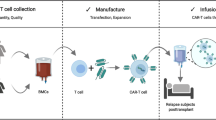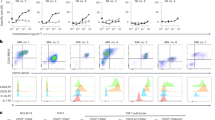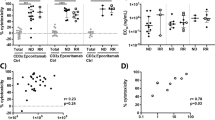Summary:
Relapse is a major problem after allogeneic transplantation in children with acute B-lineage lymphoblastic leukemias (ALL) and lymphomas and additional therapeutic strategies are needed to increase graft versus leukemia effects without inducing graft versus host disease (GvHD). Several studies have shown the efficacy of a humanized CD20 antibody (rituximab) for treatment of CD20+ malignancies together with conventional chemotherapy but less is known about its post transplant usefulness. We studied the ability of rituximab to mediate antibody-dependent cellular cytotoxicity (ADCC) and complement-dependent cytotoxicity (CDC) with effector cells and complement from patients who were transplanted with T-cell-depleted grafts from unrelated or mismatched related donors. Highest lytic activity (ADCC) was observed against leukemia-derived MHH4 cells and Burkitt's lymphoma-derived Raji cells in the first months after transplantation, corresponding to the high percentage of regenerating CD56+CD16+ cells. Moreover, primary cryopreserved ALL-blasts from a pediatric patient were also efficiently lysed. Increased lysis was obtained after stimulation with interleukin-2. Combination of ADCC and CDC had additive effects. These findings encourage clinical trials on the use of rituximab for improving minimal residual disease control and relapse prevention after allogeneic high-risk transplantation in the small group of pediatric patients with CD20+ leukemias/lymphomas.
This is a preview of subscription content, access via your institution
Access options
Subscribe to this journal
Receive 12 print issues and online access
$259.00 per year
only $21.58 per issue
Buy this article
- Purchase on Springer Link
- Instant access to full article PDF
Prices may be subject to local taxes which are calculated during checkout





Similar content being viewed by others
References
Kernan NA, Bartsch G, Ash RC et al. Analysis of 462 transplantations from unrelated donors facilitated by the National Marrow Donor Program. N Engl J Med 1993; 328: 593–602.
Ortin M, Raj R, Kinning E et al. Partially matched related donor peripheral blood progenitor cell transplantation in paediatric patients adding fludarabine and anti-lymphocyte gamma-globulin. Bone Marrow Transplant 2002; 30: 359–366.
Lang P, Handgretinger R, Niethammer D et al. Transplantation of highly purified CD34+ progenitor cells from unrelated donors in pediatric leukemia. Blood 2003; 101: 1630–1636.
Bunin N, Carston M, Wall D et al. Unrelated marrow transplantation for children with acute lymphoblastic leukemia in second remission. Blood 2002; 99: 3151–3157.
Rocha V, Cornish J, Sievers EL et al. Comparison of outcomes of unrelated bone marrow and umbilical cord blood transplants in children with acute leukemia. Blood 2001; 97: 2962–2971.
Coiffier B, Haioun C, Ketterer N et al. Rituximab (anti-CD20 monoclonal antibody) for the treatment of patients with relapsing or refractory aggressive lymphoma: a multicenter phase II study. Blood 1998; 92: 1927–1932.
Sacchi S, Federico M, Dastoli G et al. Treatment of B-cell non-Hodgkin's lymphoma with anti CD 20 monoclonal antibody Rituximab. Crit Rev Oncol Hematol 2001; 37: 13–25.
Huhn D, von Schilling C, Wilhelm M et al. Rituximab therapy of patients with B-cell chronic lymphocytic leukemia. Blood 2001; 98: 1326–1331.
Cartron G, Dacheux L, Salles G et al. Therapeutic activity of humanized anti-CD20 monoclonal antibody and polymorphism in IgG Fc receptor FcgammaRIIIa gene. Blood 2002; 99: 754–758.
Clynes RA, Towers TL, Presta LG, Ravetch JV . Inhibitory Fc receptors modulate in vivo cytoxicity against tumor targets. Nat Med 2000; 6: 443–446.
Golay J, Gramigna R, Facchinetti V et al. Acquired immunodeficiency syndrome-associated lymphomas are efficiently lysed through complement-dependent cytotoxicity and antibody-dependent cellular cytotoxicity by rituximab. Br J Haematol 2002; 119: 923–929.
Manches O, Lui G, Chaperot L et al. In vitro mechanisms of action of rituximab on primary non-Hodgkin lymphomas. Blood 2003; 101: 949–954.
Shimoni A, Hardan I, Avigdor A et al. Rituximab reduces relapse risk after allogeneic and autologous stem cell transplantation in patients with high-risk aggressive non-Hodgkin's lymphoma. Br J Haematol 2003; 122: 457–464.
Lang P, Pfeiffer M, Handgretinger R et al. Clinical scale isolation of T cell-depleted CD56+ donor lymphocytes in children. Bone Marrow Transplant 2002; 29: 497–502.
Brugger W . Clearing minimal residual disease with rituximab consolidation therapy. Semin Oncol 2004; 31 (1 Suppl. 2): 33–37.
Ruggeri L, Capanni M, Urbani E et al. Effectiveness of donor natural killer cell alloreactivity in mismatched hematopoietic transplants. Science 2002; 295: 2097–2100.
Golay J, Manganini M, Facchinetti V et al. Rituximab-mediated antibody-dependent cellular cytotoxicity against neoplastic B cells is stimulated strongly by interleukin-2. Haematologica 2003; 88: 1002–1012.
Friedberg JW, Neuberg D, Gribben JG et al. Combination immunotherapy with rituximab and interleukin 2 in patients with relapsed or refractory follicular non-Hodgkin's lymphoma. Br J Haematol 2002; 117: 828–834.
Lang P, Greil J, Schumm M . Boosts with highly purified stem cells following allogeneic transplantation from alternative donors. Bone Marrow Transplant 2003; 31: 238.
Hillmen P . Advancing therapy for chronic lymphocytic leukemia – the role of rituximab. Semin Oncol 2004; 31 (1 Suppl. 2): 22–26.
Anderson KC, Bates MP, Slaughenhoupt BL et al. Expression of human B cell-associated antigens on leukemias and lymphomas: a model of human B cell differentiation. Blood 1984; 63: 1424–1433.
Lang P, Barbin K, Feuchtinger T et al. Chimeric CD19 antibody mediates cytotoxic activity against leukemic blasts with effector cells from pediatric patients who received T-cell-depleted allografts. Blood 2004; 103: 3982–3985.
Acknowledgements
We thank A Babarin-Dorner for excellent technical assistance, Karin Schilbach, PhD and Barbara Lang, MD, for helping prepare the manuscript. This work was supported by grants from the German José Carreras Leukemia Foundation, the Deutsche Forschungsgemeinschaft (SFB 510) and from the Reinhold Beitlich Stiftung, Tuebingen, Germany.
Author information
Authors and Affiliations
Corresponding author
Rights and permissions
About this article
Cite this article
Pfeiffer, M., Stanojevic, S., Feuchtinger, T. et al. Rituximab mediates in vitro antileukemic activity in pediatric patients after allogeneic transplantation. Bone Marrow Transplant 36, 91–97 (2005). https://doi.org/10.1038/sj.bmt.1705014
Received:
Accepted:
Published:
Issue Date:
DOI: https://doi.org/10.1038/sj.bmt.1705014
Keywords
This article is cited by
-
Clinical impact of NK-cell reconstitution after reduced intensity conditioned unrelated cord blood transplantation in patients with acute myeloid leukemia: analysis of a prospective phase II multicenter trial on behalf of the Société Française de Greffe de Moelle Osseuse et Thérapie Cellulaire and Eurocord
Bone Marrow Transplantation (2017)
-
Natürliche Killerzellen in der Leukämie- und Tumortherapie
Monatsschrift Kinderheilkunde (2010)
-
Allogeneic hematopoietic stem cell transplantation after rituximab-containing myeloablative preparative regimen for acute lymphoblastic leukemia
Bone Marrow Transplantation (2006)
-
The CD20/αCD20 ‘suicide’ system: novel vectors with improved safety and expression profiles and efficient elimination of CD20-transgenic T cells
Gene Therapy (2006)



